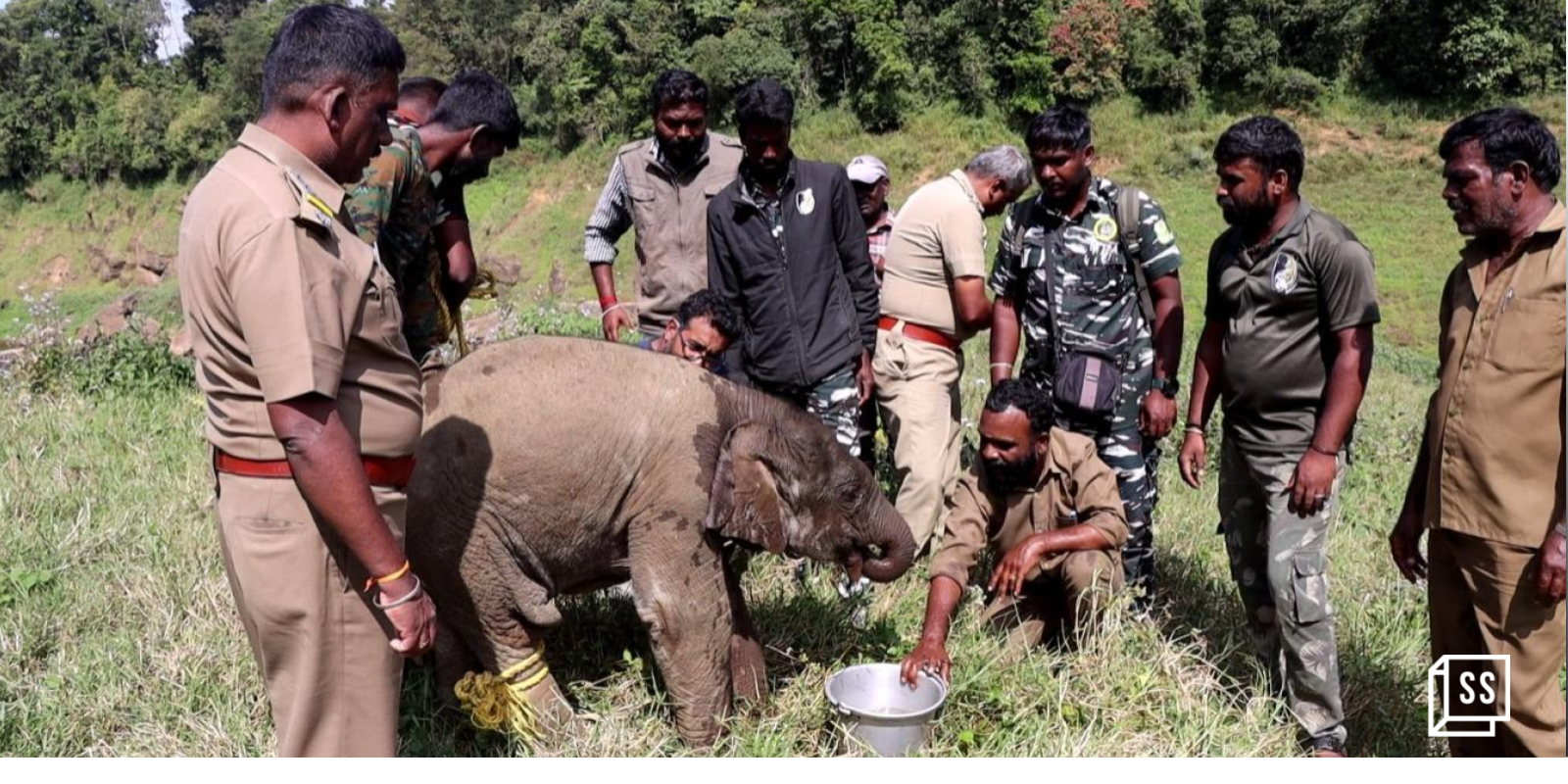How TN forest officials are reuniting lost elephant calves with their families
From mapping misty tropical forests to ensuring minimal human imprint on lost and stranded fauna, forest rangers and staff work relentlessly to send elephant calves back to their families.
The visuals of a baby elephant snuggling up against its mother on a rock at the tropical jungles of the Annamalai Tiger Reserve in Pollachi, Tamil Nadu, marked a heartwarming beginning to this year last week, reaching thousands of internet users across the world.
Supriya Sahu, the Government of Tamil Nadu’s Additional Chief Secretary, Environment Climate Change and Forests, posted the video while recounting how the forest rangers’ conscientious planning and execution in reuniting the lost male calf with its family paid off after half a day of careful monitoring and journeying through valleys and forests with the baby.
This was the first reunion of its kind in close to two years since 2022, when a calf that got separated from its mother following heavy rains near the Sigurhalla river in the Nilgiris was reunited after an arduous three-day-long effort by the Tamil Nadu Forest Department.
Tamil Nadu is the only state to have a comprehensive Standard Operating Procedure (SOP) for Orphaned Elephant Calves Management, which was introduced in August last year. Contributing knowledge and resources to the SOP are forest department staff, mahouts, veterinarians, and cavadis from different tiger reserves. The SOP outlines crucial steps towards reuniting stranded elephant calves with their herds.
“The SOP has been developed by The Advanced Institute of Wildlife Conservation, which is our own technical agency. It offers a detailed guide on what to do when you find a stranded calf, and how to avoid leaving human imprints on the calf as much as possible, as that would reduce their chances of being accepted back into the herd again,” says Sahu.
Experts say it is common for herds to move along when a member is missing, but they say a smaller group usually hangs around to locate the missing calf. However, sometimes, the herd as a whole tends to move away for safety from predators, and loses calves in zones that have high animal-human conflict, said Kartick Satyanarayan, Chief Executive of Wildlife SOS, in an interview with The Guardian.
“The matriarch has to choose between the welfare of the herd and the welfare of one calf,” he said.
A seasonal job
There are close to 3,000 elephants in Tamil Nadu, says Sahu.
The period between October and March is one of the busiest for the state’s forest department. It is when close to 200 elephants migrate between Tamil Nadu and Kerala, according to A Manikandan, Forest Range Officer of the Manampalli range in Valparai.
Through this heavy duty period, a biologist sits at the District/Divisional Forest Officer (DFO) cell, mapping the dense shola forests of Tamil Nadu’s tiger reserves, and anti-poaching watchers and rangers collaborate with tea estate workers to ensure the moving herds of pachyderms don’t destroy ration shops and household kitchens in search of food, as has often been the case.

The video of the four-month-old elephant calf snuggling up against its mother at the Anamalai Forest Reserve went viral last week.
“Many of our on-ground workers are tribals, who have a trained nose to pick up the scent of an elephant that’s less than 200 metres away,” says Manikandan. “With the help of our teams, an elephant movement report is given to our biologist, and herds are identified and named, to help us closely monitor where they go,” says Manikandan.
To monitor areas of the forests where there is little visibility and path for vehicles, drones are deployed to monitor elephant movements, a method used for the latest rescue as well.
Human casualties may take place when elderly staff on duty cannot hear herds walking towards them or while being chased. These instances have reduced a great deal over the last two years due to intense monitoring efforts, he says Manikandan.
The complexities of rescue and reuniting
Reuniting an elephant calf with its family is crucial to it living a life of good quality, says Sahu. “Lost calves that are not reunited with their herd spend the rest of their lives in captivity in a camp. It is impossible for them to survive alone in the jungle,” says Sahu.
Experts say calves that are separated from their herds while escaping from predators or due to natural disasters have higher chances of being reunited. They point out that elephants use chemical signals from dung and urine to communicate with lost members of the herd over long distances.
In some rare cases--like in the story of Bomman and Bellie of The Academy Award-Winning ‘The Elephant Whisperers’--orphaned baby elephants rescued by humans adapt in encouraging ways to coexist, while in some other instances, kumki or trained Asian captive elephants help with the rescue and rehabilitation of lost calves.

Directing the calf to move towards its herd with minimal human imprint and interaction is key to reuniting them with their family.
“Our goal is always to have minimal human interaction and touch with calves that are less than a year old, that cannot graze on their own, and need their mother’s milk,” says Manikandan.
“It also matters how active they are--as was our latest rescue. If a calf is active, it doesn’t need us to provide food, which may lead to indigestion and other issues, considering if it has only been feeding on its mother’s milk,” he says.
A strong record of elephant groups in the region, broken down to the number of tuskers, male and female elephants in each of them, and their movement habits, helps the department identify herds with missing members and complete them.
Over the last two years, two elephant calves have been reunited with their herds by the Tamil Nadu Forest Department.
“In cases where human imprints are unavoidable, we bathe the calf in the river and smear it with soil to remove our scents from it--something we did with our latest rescue as well. Our first and most important attempt is always to reunite calves with their herds and put them back into their natural habitats. It is what we are trained to do for animals amid rising human-animal conflicts.”
Edited by Megha Reddy










